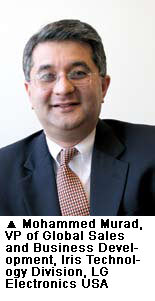Biometrics are part of a person's identity. Nowadays, biometrics not only provide a high level of security but also create a positive personal and corporate image. A&S takes a look at current trends and technology.
Biometrics are part of a person's identity. Nowadays, biometrics not only provide a high level of security but also create a positive personal and corporate image. A&S takes a look at current trends and technology.
The worldwide market for biometrics is about US$3.5 billion in 2009 and about $4.5 billion in 2010, said Billy Tang, CEO at Titanium Technology. This represents the importance of credential and identity management in society today and in the future.
Card-based access control systems are being replaced by biometric systems, as facial, iris and hand geometry recognition become more mature. With lowered prices and better market education, the biometrics market has great potential.
Governments worldwide are increasing their use of biometrics in identification cards and passports, creating strong demand for biometrics, especially facial recognition, Tang said.
Biometrics makes a security solution more complete. Commercial sector also has increased demand for facial, vein and voice recognition due to its high ROI, said Dato Boon Han Lee, Executive Director and Deputy CEO at RCG.
 Applications
Applications
Biometric devices have been successfully deployed worldwide in government, health care, financial services, manufacturing, retail and other environments. Consumer-facing applications range from time and attendance to border security, citizen identification, mobile phone access, residential and nuclear power plant access.
Facial recognition is popular in coal mines, factories, casinos, heath care facilities, data centers and enterprises, Tang said. It is contactless and convenient for areas where hygiene might be an issue if physical contact is required. Access control with facial recognition is especially popular in the Asian market, said Charles Francisco, CEO at XID Technologies.
 Facial recognition is less intrusive, compared to other biometric identifiers. It can be integrated with surveillance and access control systems to detect and identify individuals. Police can also use the data to identify and capture criminal suspects.
Facial recognition is less intrusive, compared to other biometric identifiers. It can be integrated with surveillance and access control systems to detect and identify individuals. Police can also use the data to identify and capture criminal suspects.
Hand geometry recognition is popular in the banking and construction sectors. In banks, two-man or three-man hand geometry recognition is mostly used. At construction sites, hand geometry is used to keep out illegal workers and prevent buddy punching.
There are more than 1,000 construction sites in Hong Kong using hand geometry for access control and some cities in Dubai and China have started to do the same, said Tony K.W. Yuen, COO at Solution Expert.
 Other than hand geometry, back of hand vascular recognition is also used in construction sites, factories, military bases, airports and other government facilities, said Alex Hwansoo Choi, President and CEO at Techsphere.
Other than hand geometry, back of hand vascular recognition is also used in construction sites, factories, military bases, airports and other government facilities, said Alex Hwansoo Choi, President and CEO at Techsphere.
Iris recognition has a sweet spot in workforce management. Minimizing time theft results in improved bottom line performance. Industry estimates time theft in the range of 1.5 to 10 percent of gross payroll, costing businesses globally hundreds of billions of dollars every year, said Mohammed Murad, VP of Global Sales and Business Development, Iris Technology Division, LG Electronics USA.
Integration of different biometrics into one system increases accuracy, making  multimodal solutions popular. Palm geometry, iris, facial recognition and fingerprint are commonly combined, said Yuen.
multimodal solutions popular. Palm geometry, iris, facial recognition and fingerprint are commonly combined, said Yuen.
Multimodal systems have higher selling point on the market, said Dave Zhao, Product Manager at ZKSoftware.
Furthermore, applications used in everyday life scenarios are providing an even larger market potential for biometric systems. In Japan, biometrics not only provide security but also make life more comfortable, said Sadi Vural, President and CEO at Ayonix. Not only banks use biometrics to replace ATM cards, shops and department stores also use biometrics for marketing purposes. While different verticals prefer different biometric identifiers, a truly customized solution is the key.
Technology
Biometric systems today are more reliable, stabile and user-friendly with stylish design, said Jack Kao, President at Face-Tek Technology. The latest facial recognition solution uses two cameras — one CCD camera and an IR camera — to capture facial images for 3D recognition, said Yuen.
A critical issue for facial recognition is minimizing environmental effects on image  capture. A 3D illumination synthesis technology can remove environmental effects, normalizing the picture for high accuracy verification, Vural said.
capture. A 3D illumination synthesis technology can remove environmental effects, normalizing the picture for high accuracy verification, Vural said.
Facial recognition can also be integrated with VIP identification software, enabling more versatile applications, said Kao.
With the latest technology, twins can be identified separately by 3D facial recognition, which can perform verifications according to a user's physical changes over time. Now there are also stand-alone systems with multiple access control features, such as facial recognition, fingerprint, smart cards and PIN codes in customized combinations, to further increase security, Zhao said.
Iris scanning has great technology breakthroughs. Iris scanning of individuals at a distance and in motion are promising developments. "The system operates with high speed and does dual iris, face and fingerprint capture," Murad said.
Another biometric identifier, back of hand vascular pattern recognition, uses infrared optical technology to view blood vessel patterns and analyze them. This  technology can achieve high usability with a low false-acceptance rate (FAR), Choi said.
technology can achieve high usability with a low false-acceptance rate (FAR), Choi said.
Palm vascular recognition, or vein recognition, uses near-range IR to read palm vein patterns. Vein recognition is unique to individuals — in 10 million people, only eight people would have similar vein patterns. A contactless design solves the hygiene issue for biometric systems, said Eric Cheng, General Manager at Taiwan Jantek Electronics.
"While biometric technology is already mature, product differentiation is about developing more applications such as access control, T&A and identity authentication that fit the enterprises' needs," Yuen said.
Selection Criteria
Accuracy, reliability, usability, robustness to forgery, cost, user acceptance and interoperability are important selection criteria for biometric systems.
The most important thing about biometric access control is not its ability to allow access but to grant access only to the correctly authorized people, said Kao.
Other than that, usability is very important in large-scale applications. If usability is  poor and some people in a user group cannot use the device, the system would have to provide back door security for those who cannot use the machine. However, once a back door is provided, the system is no longer secure, Choi said. Failure-to-enroll rates should be considered, especially for iris and palm recognition systems.
poor and some people in a user group cannot use the device, the system would have to provide back door security for those who cannot use the machine. However, once a back door is provided, the system is no longer secure, Choi said. Failure-to-enroll rates should be considered, especially for iris and palm recognition systems.
Systems achieving these requirements have high ROI. Users are looking for systems that can integrate with human resources, documentation systems or immigration and passports. Systems that are easy to install, integrate and manage are preferred by installers.
When selecting biometric systems, it is not about picking products with the most features, but selecting products that best suit installation requirements, Zhao said. For example, biometric systems with higher false-rejection rates (FRRs) are better suited for high security, while higher FARs perform better in corporate offices.
Challenges
Technology barriers, cost and user education are three main challenges. Currently  there is not a single biometric technology which completely suits all applications. A high-performance biometric product is expensive and works slowly, while product that works fast often has a low level of accuracy, Vural said. Other than that, lighting issues always exist in facial recognition.
there is not a single biometric technology which completely suits all applications. A high-performance biometric product is expensive and works slowly, while product that works fast often has a low level of accuracy, Vural said. Other than that, lighting issues always exist in facial recognition.
Cost and system complexity are two other issues affecting the deployment of iris and vein recognition. Both biometric systems provide more security by collecting more data points, but are more expensive. Users must be informed about the benefits of these systems to appreciate them.
The lack of education has always been a challenge for the uptake of biometric systems. People are sensitive about providing their biometric information, mainly due to fear of identity theft, invasion of privacy and health concerns. For biometrics to be more widely accepted, understanding customer concerns are crucial.
However, biometrics do not have the risk of infringement or duplication, because biometric information is coded by an algorithm that cannot be decoded easily, Lee said. Different systems on the market have different algorithms, meaning that even  if the database was stolen, other biometric systems cannot identify the code. With biometric systems, only the person with the right biometric characteristics can be identified.
if the database was stolen, other biometric systems cannot identify the code. With biometric systems, only the person with the right biometric characteristics can be identified.
Manufacturers must also explain their benefits for an installation. "By informing installers about the exact benefits of biometric systems, such as providing them with clear product demonstrations and comprehensive after-sale services, it could help biometrics gain market acceptance," Zhao said.
Future Trends
Biometrics are moving towards consumer applications, linking more closely with daily activity. For example, users do not have to type in a password to turn on computers, said Francisco.
Entry-level products at lower prices will become more popular. Vein recognition would be the next most popular product after its price is reduced, Zhao said. The industry is changing rapidly, as biometrics will dominate the worldwide market within 10 years, Vural said.

Technology-wise, compact portable devices, facial recognition on the move and facial recognition video analytics will be popular. With lower prices and smaller systems becoming available, residential adoption will increase, Lee said.
The need for integrated biometric solutions, multiple biometric and biometric combined with RFID devices will increase. Other than that, biometric products embedded into mobile electronic devices will be a trend for the future, Vural said.